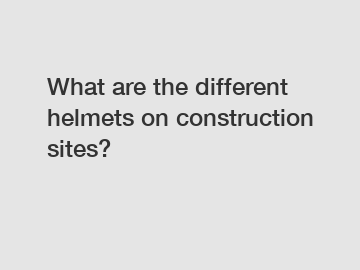What are the different helmets on construction sites?
Construction sites are known for being high-risk environments, with potential hazards lurking around every corner. One of the most important safety measures taken on construction sites is the use of helmets. Helmets not only protect workers from falling debris but also help prevent head injuries in case of accidents. There are different types of helmets used on construction sites, each serving a specific purpose and providing different levels of protection. In this article, we will explore the various helmets used in the construction industry and their roles in keeping workers safe.
Hard Hats: Hard hats are the most common type of helmet used on construction sites. They are designed to protect the wearer's head from falling objects, impact injuries, and electrical shocks. Hard hats are made of durable materials such as high-density polyethylene or fiberglass and are equipped with a suspension system to absorb impacts. They come in different colors, with each color representing a specific role or job on the construction site. For example, white hard hats are usually worn by managers or engineers, while yellow hard hats are worn by general laborers.
Bump Caps: Bump caps are lightweight helmets designed to protect the wearer's head from minor bumps and scrapes. They are not designed to provide the same level of protection as hard hats but are suitable for workers who are at a lower risk of head injuries. Bump caps are often worn by workers in industries where there is a risk of bumping into low-hanging objects or overhead structures, such as warehouses or distribution centers.

Rescue Helmets: Rescue helmets are specially designed for workers involved in rescue operations or working at heights. These helmets are equipped with chin straps, ear protection, and face shields to provide maximum protection to the wearer. Rescue helmets are often used by firefighters, search and rescue teams, and workers in the telecommunications industry.
Welding Helmets: Welding helmets are designed to protect the wearer's eyes and face from the intense heat and bright light generated during welding operations. These helmets are equipped with a shaded lens that automatically darkens when exposed to welding arcs, preventing eye damage and vision impairment. Welding helmets also provide protection from sparks, spatter, and flying debris, making them essential for welders working on construction sites.
Full-Face Helmets: Full-face helmets provide comprehensive protection to the wearer's head, face, and neck. These helmets are equipped with a visor or face shield that covers the entire face, protecting workers from flying debris, chemicals, and hazardous materials. Full-face helmets are commonly used in industries where there is a high risk of facial injuries, such as demolition, concrete cutting, and metal fabrication.
Safety Helmets: Safety helmets are designed to provide all-around protection to the wearer's head and neck. These helmets are equipped with additional safety features such as chin straps, ear protection, and reflective strips for increased visibility. Safety helmets are commonly used in high-risk construction activities such as working at heights, confined spaces, and heavy machinery operation.
Ventilated Helmets: Ventilated helmets are designed to provide maximum comfort to the wearer, especially in hot and humid conditions. These helmets are equipped with ventilation holes or mesh panels to allow air circulation and prevent heat buildup. Ventilated helmets help prevent heat-related illnesses such as heat stroke and heat exhaustion, allowing workers to stay cool and focused on their tasks.
In conclusion, helmets are an essential safety gear on construction sites, providing protection against head injuries, impacts, and other risks. It is important for workers to wear the appropriate helmet for their specific job requirements and to ensure that the helmet is properly fitted and maintained. By understanding the different types of helmets available and their roles in keeping workers safe, construction companies can create a safer work environment for their employees. Stay safe, stay protected!
The company is the world’s best industrial safety helmet, wholesale food safety boots , Anti-Slip Wellington Rubber Boots supplier. We are your one-stop shop for all needs. Our staff are highly-specialized and will help you find the product you need.



